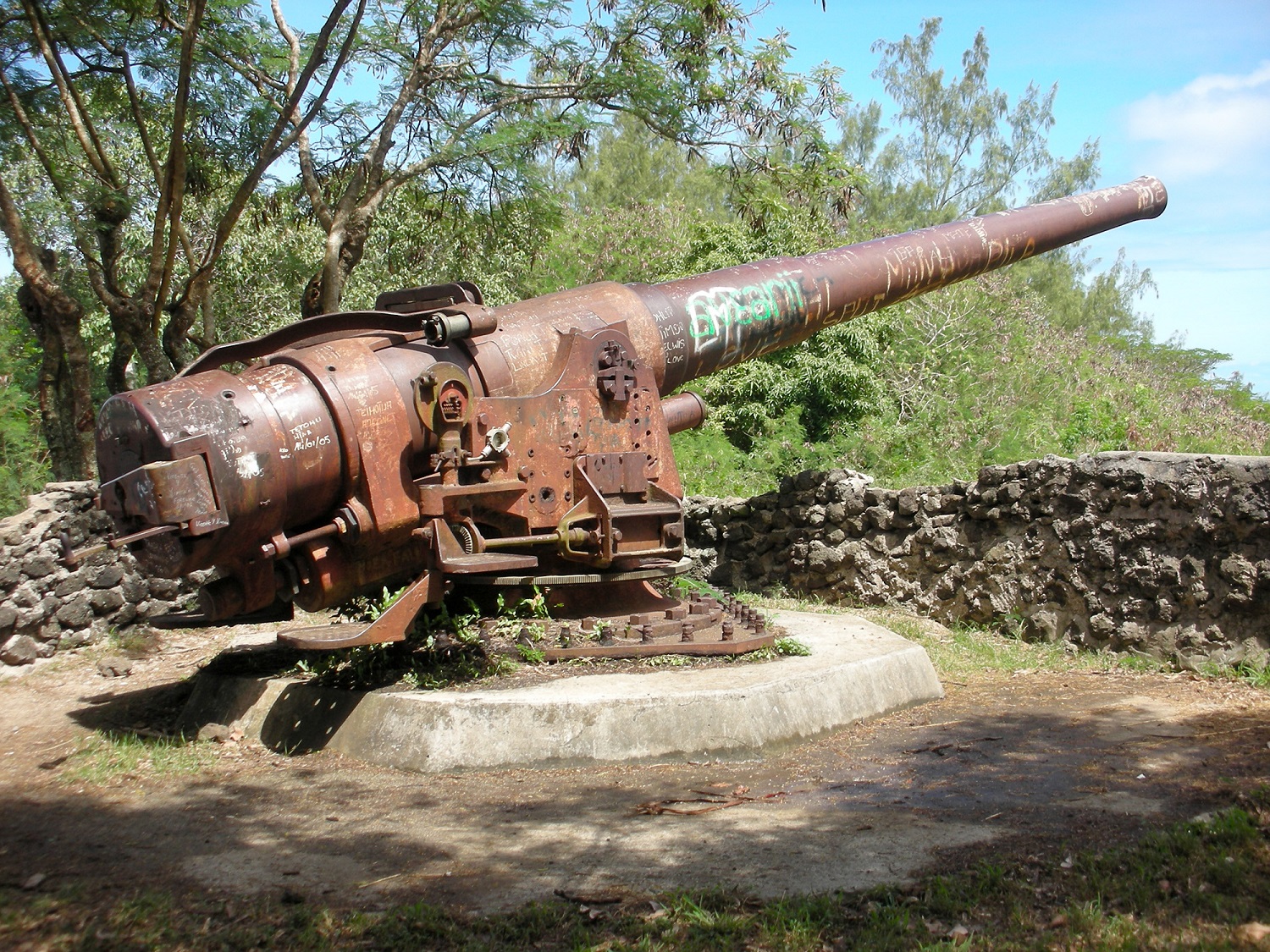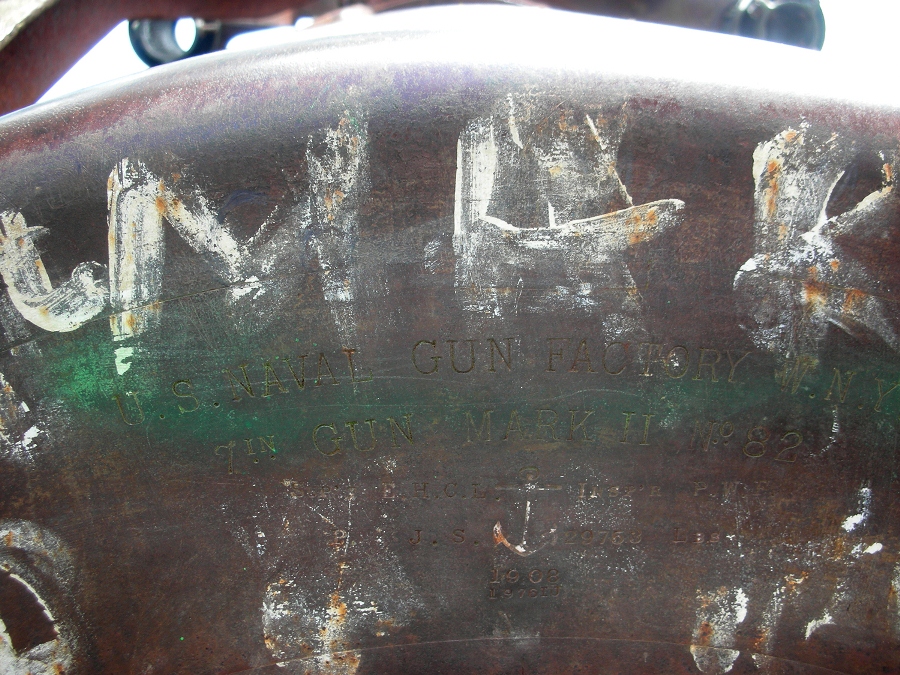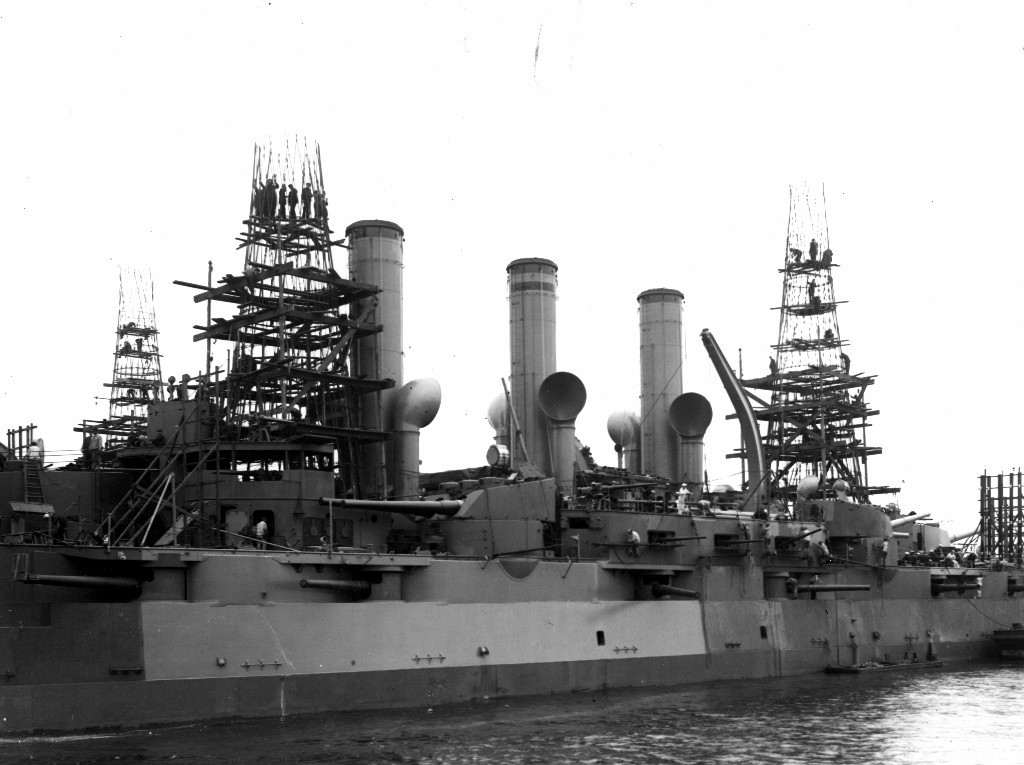
Used as secondary guns on the last US pre-dreadnought classes. This caliber was selected as it was considered to be the largest possible given the technology of the time that was suitable for a rapid-fire (RF) secondary gun.
Many guns removed from old battleships were used as mobile land artillery (tractor mountings) during World War I. The tractor mountings were designed by BuOrd and built by the Baldwin Locomotive Works in Philadelphia, Pennsylvania. The U.S. Marines ordered 20 of these guns and the Army ordered 34 more. 18 guns were delivered to the Marines and 20 to the Army prior to the Armistice, but none of these were actually used in France. One of the tractor mountings still exists and has been restored, as can be seen below. An additional number of guns, still in their naval pedestal mountings, were used as railway guns during World War I.
During World War II, about 22 of the surviving guns were used in emergency coastal defense batteries. Two of these coastal guns still exist at Ft. Derussy at Pearl Harbor, Hawaii. Seven of the eight guns that were mounted at Bora Bora, French Polynesia, still exist in place as of 2022.
In 1908 AP projectiles were fitted with a longer ballistic cap of 7crh which improved their penetration ability at longer ranges.
Mark 1 was the prototype gun design and only one was manufactured. This was designated as Serial Number 1 and was constructed of liner, tube, jacket, three hoops and a locking ring. It had a screw-box liner and was hooped from breech to 47.5 inches (120.65 cm) from the muzzle. Equipped with an experimental Welin breech block and uniform rifling 1/25. Mark 2 was of similar construction but was hooped all the way to the muzzle and had increasing rifling 0 to 1/25. It was also one caliber or some 7" (17.8 cm) longer than the Mark 1. Mark 2 Mod 1 had a conical nickel-steel liner. There were also two experimental Mark 2 guns, Serial Numbers 2 and 3, which had wider diameter breech ends. Gun S/N 2 was later modified to become the Mark 2 Mod 2 by giving it a conical nickel-steel liner and a modified breech mechanism.
There were 112 of these guns built by the Naval Gun Factory, Watervliet Arsenal, Bethlehem Steel and Midvale Steel.
| Designation | 7"/44 (17.8 cm) Mark 1
7"/45 (17.8 cm) Mark 2 |
|---|---|
| Ship Class Used On | Connecticut (B-18) and Mississippi (B-23) Classes |
| Date Of Design | about 1900 |
| Date In Service | 1906 |
| Gun Weight | 12.8 tons (13.0 mt) |
| Gun Length oa | Mark 1: 316.0 in (8.026 m)
Mark 2: 323.0 in (8.204 m) |
| Bore Length | Mark 1: 308 in (7.823 m)
Mark 2: 315 in (8.001 m) |
| Rifling Length | N/A |
| Grooves | N/A |
| Lands | N/A |
| Twist | Mark 1: Uniform RH 1 in 25
Mark 2: Increasing RH 0 to 1 in 25 |
| Chamber Volume | N/A |
| Rate Of Fire | 4 rounds per minute |
| Type | Bag |
|---|---|
| Projectile Types and Weights 1 2 | AP Mark 6 Mods 0 and 1 - 165 lbs. (74.8 kg)
AP Mark 10 Mod 2 - 165 lbs. (74.8 kg) AP Mark 12 Mods 1 and 2 - 165 lbs. (74.8 kg) Common - 165 lbs. (74.8 kg) Field Mark 13 Mods 1 and 2 - 152 lbs. (68.9 kg)
|
| Bursting Charge | AP Mark 6 - 4.31 lbs. (2.0 kg) Explosive D
AP Mark 10 - 4.31 lbs. (2.0 kg) Explosive D AP Mark 12 Mod 1 - 4.0 lbs. (1.8 kg) Explosive D AP Mark 12 Mod 2 - 3.5 lbs. (1.6 kg) Explosive D Common - 5.5 lbs. (2.5 kg) Explosive D Field Mark 13 - 24 lbs. (10.9 kg) Cast TNT
|
| Projectile Length | AP Mark 6 - 23.64 in (60.0 cm)
AP Mark 10 - 23.73 in (60.3 cm) AP Mark 12 - 23.68 in (60.1 cm) Common - about 23.64 in (60.0 cm) Field Mark 13 - 29.58 in (75.1 cm)
|
| Propellant Charge | 58 lbs. (26.3 kg) SPD |
| Muzzle Velocity | 2,700 fps (823 mps) |
| Working Pressure | 17.0 tons/in2 (2,680 kg/cm2) |
| Approximate Barrel Life | N/A |
| Ammunition stowage per gun | Connecticut class: 100 rounds
Mississippi class: 111 rounds |
- ^All AP projectiles had almost identical nose shapes, but the designs were very different. AP Mark 6 had no ballistic cap, but the AP cap was essentially shaped like a thick-walled ballistic cap. AP Mark 10 had a ballistic cap covering a flat-nosed AP cap. AP Mark 12 had a ballistic cap covering a concave AP cap. See sketch below.
- ^Field and Bombardment rounds were developed for Marine and Army artillery units, they were not used on ships. These had similar projectile shapes, but the Field round did not have a base fuze.
- Bourrelet diameter for AP Mark 6 was 6.990 inches (17.8 cm). All other rounds had a bourrelet diameter of 6.985 inches (17.7 cm).
| Elevation | Distance | Striking Velocity | Angle of Fall | Time of Flight
(seconds) |
Maximum Ordinate |
|---|---|---|---|---|---|
| 3.0 degrees | 6,000 yards (5,490 m) | 1,810 fps (552 mps) | 3.9 | 8.17 | 269 feet (82 m) |
| 4.1 degrees | 7,500 yards (6,860 m) | 1,635 fps (498 mps) | 5.7 | 10.80 | 471 feet (144 m) |
| 15 degrees | 16,500 yards (15,090 m) | --- | --- | --- | --- |
| Range | Side Armor | Deck Armor |
|---|---|---|
| 0 yards (0 m) | 9.60" (244 mm) | --- |
| 6,000 yards | 5.21" (132 mm) | --- |
| 9,000 yards | 3.84" (98 mm) | --- |
| 12,000 yards | 3.43" (87 mm) | --- |
These figures are taken from USN armor penetration curves published in 1942 as shown in "US Naval Weapons". The data is for face-hardened Harvey plates from "Ordnance Data Sheets" of 1905 and is for the older shell design.
| Range | Side Armor | Deck Armor |
|---|---|---|
| 6,000 yards (5,490 m) | 6.3" (160 mm) | --- |
| 9,000 yards (8,230 m) | 4.3" (109 mm) | --- |
| 12,000 yards (10,920 m) | 3.2" (81 mm) | --- |
These figures are taken from USN armor penetration curves published in 1942 as shown in "US Naval Weapons". The data is from "Elements of US Naval Guns" of 1918 and is for the 7crh projectile at a muzzle velocity of 2,400 fps (732 mps). Data is corrected for angle of fall and may also refer to harder armor than used for the 1905 data.
| Designation | Single pedestal type for casemates
Connecticut (12) and Mississippi (8): Mark 1 and Mark 2 |
|---|---|
| Weight | 25 tons (26 mt) |
| Elevation | -7 / +15 degrees 1a |
| Elevation Rate | N/A |
| Train | about +150 / -150 degrees |
| Train Rate | N/A |
| Gun recoil | Nominal: 19 in (48 cm)
Maximum: 21 in (53 cm) |
| Loading angle | Any angle |
- ^The World War I tractor mounting allowed a maximum elevation of 40 degrees. At this angle, a maximum range of about 24,000 yards (21,900 m) could be achieved. As this elevation was much higher than the naval mounting, a new counter-recoil system was designed for it.
- The railway units used the Mark 2 Mod 3 naval mounting together with a special adapter casting, which both mated the gun pedestal to the railway car and raised the gun muzzle to a safe clearance height above the car. The casting weighed about 13,000 lbs. (5,900 kg). This mounting allowed a full 360 degrees of traverse. The railroad car itself was a drop-frame type that needed to be lowered to the rails and its four outriggers set up before the gun could be fired. See photograph below.
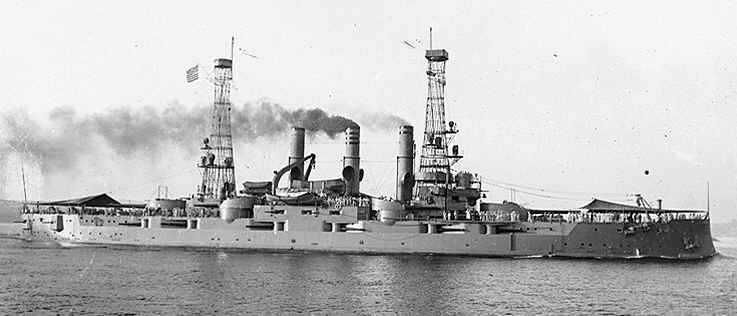
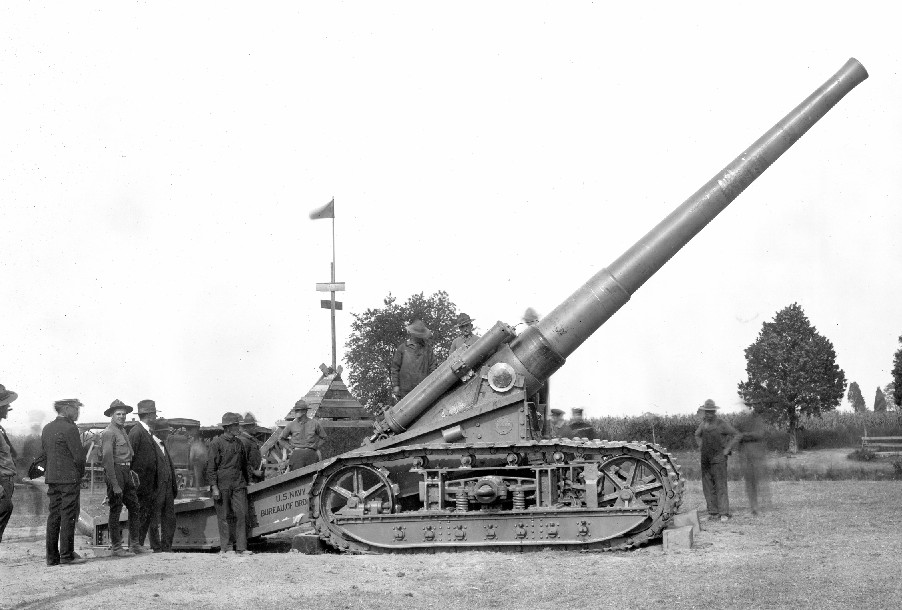
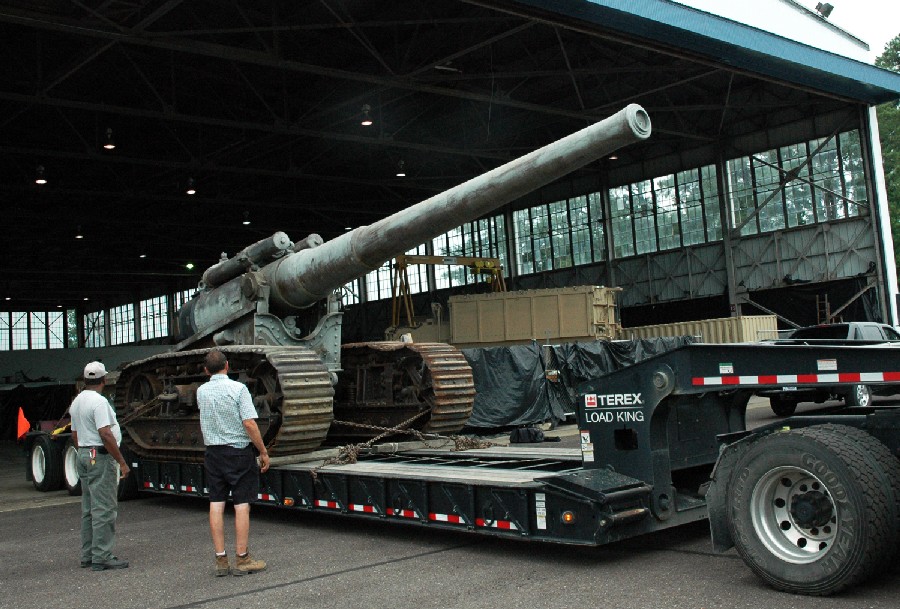
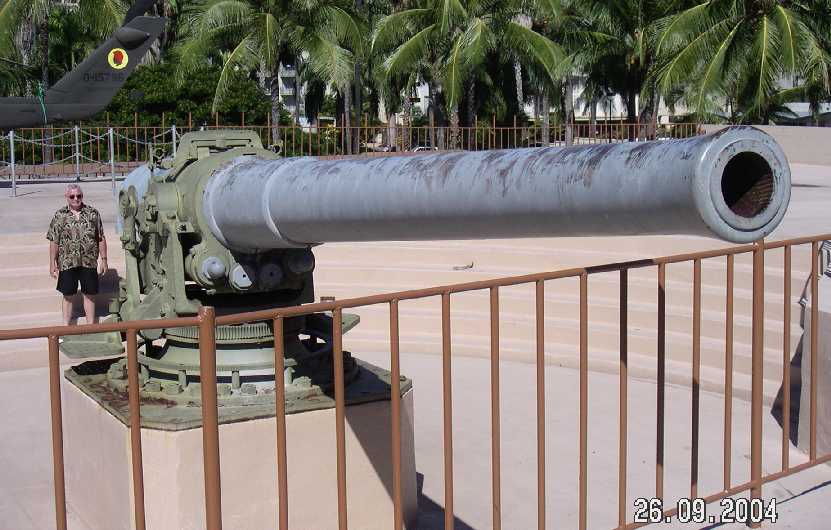
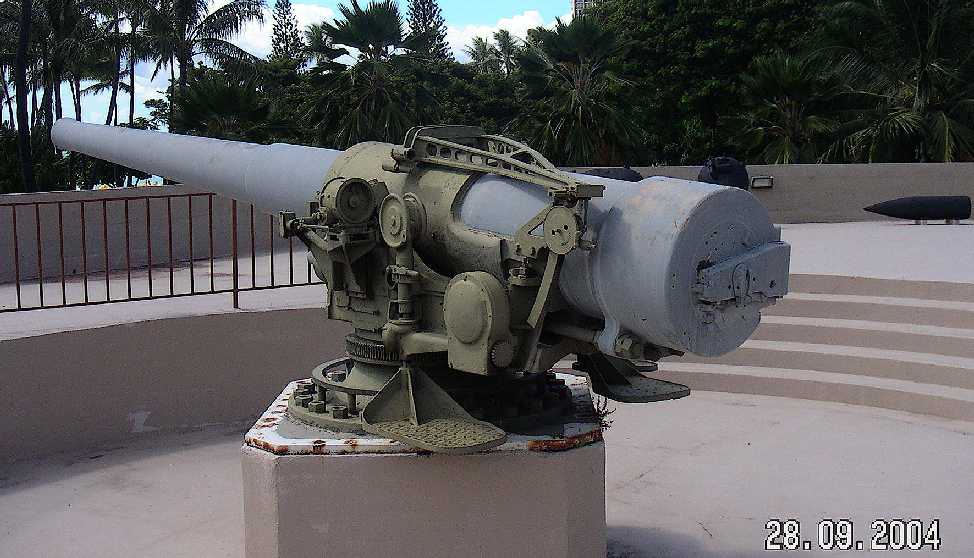
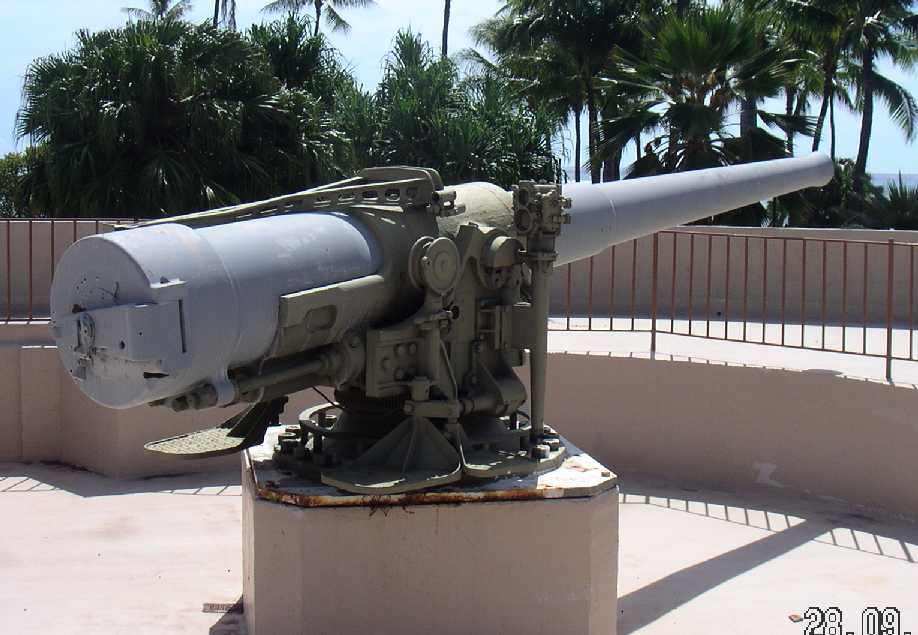
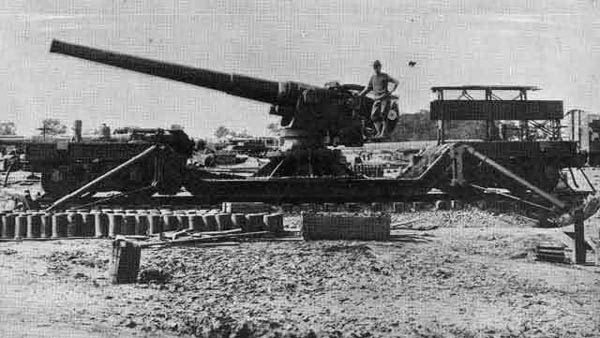
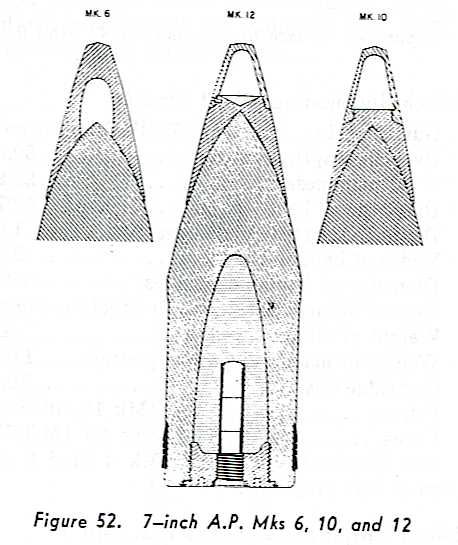
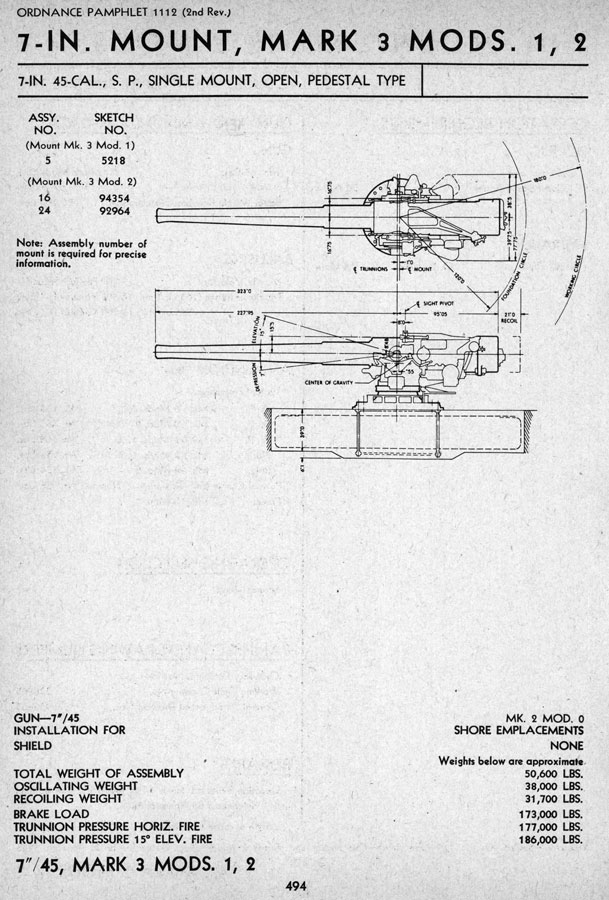
Four two-gun batteries were installed on the French Polynesian Island of Bora Bora during World War II. These batteries are locally known as Faanui (North Battery), Anau Fort (East Battery), Matira (South Battery) and Cannoni Americani (West Battery). Seven of these guns are still in position while one gun barrel at the North Battery has been dismounted and moved to a private residence, but its carriage still remains at the North Battery. All guns are Mark 2 (Mod 0) design. Special thanks to David Chessum, who hiked to each battery in December 2022 to examine and photograph each gun.
| Battery | Manufacturer | Serial Number | Source |
|---|---|---|---|
| North | Bethlehem | 100 | Spares |
| North | U.S. Naval Gun Factory W.N.Y. - Gun moved to private residence | 97 | Spares |
| East | Watervliet Arsenal | 69 | USS Kansas |
| East | Watervliet Arsenal | 60 | USS Louisiana |
| West | U.S. Naval Gun Factory W.N.Y. | 82 | Spares |
| West | Watervliet Arsenal | 57 | USS Louisiana |
| South | U.S. Naval Gun Factory W.N.Y. | 81 | Spares |
| South | U.S. Naval Gun Factory W.N.Y. | 96 | Spares |
A Note on Sources: Local history on Bora Bora says that all of these guns were from USS Connecticut (B-18) but the NARA Archives show the following usage:
USS Mississippi (B-23) S/N 4-11
USS Idaho (B-24) S/N 12-14, S/N 75-79
USS Connecticut (B-18) S/N 15-26
USS Minnesota (B-22) S/N 27-38
USS Vermont (B-20) S/N 39-50
USS Louisiana (B-19) S/N 51-60, S/N 62-63
USS Kansas (B-21) S/N 61, S/N 64-74
USS New Hampshire (B-25) S/N 83-94
Spare Stock S/N 80-82, S/N 95-112
As noted above, S/N 1 was the only Mark 1 gun manufactured while S/N 2 and 3 were prototype Mark 2 guns used only for experimental purposes.
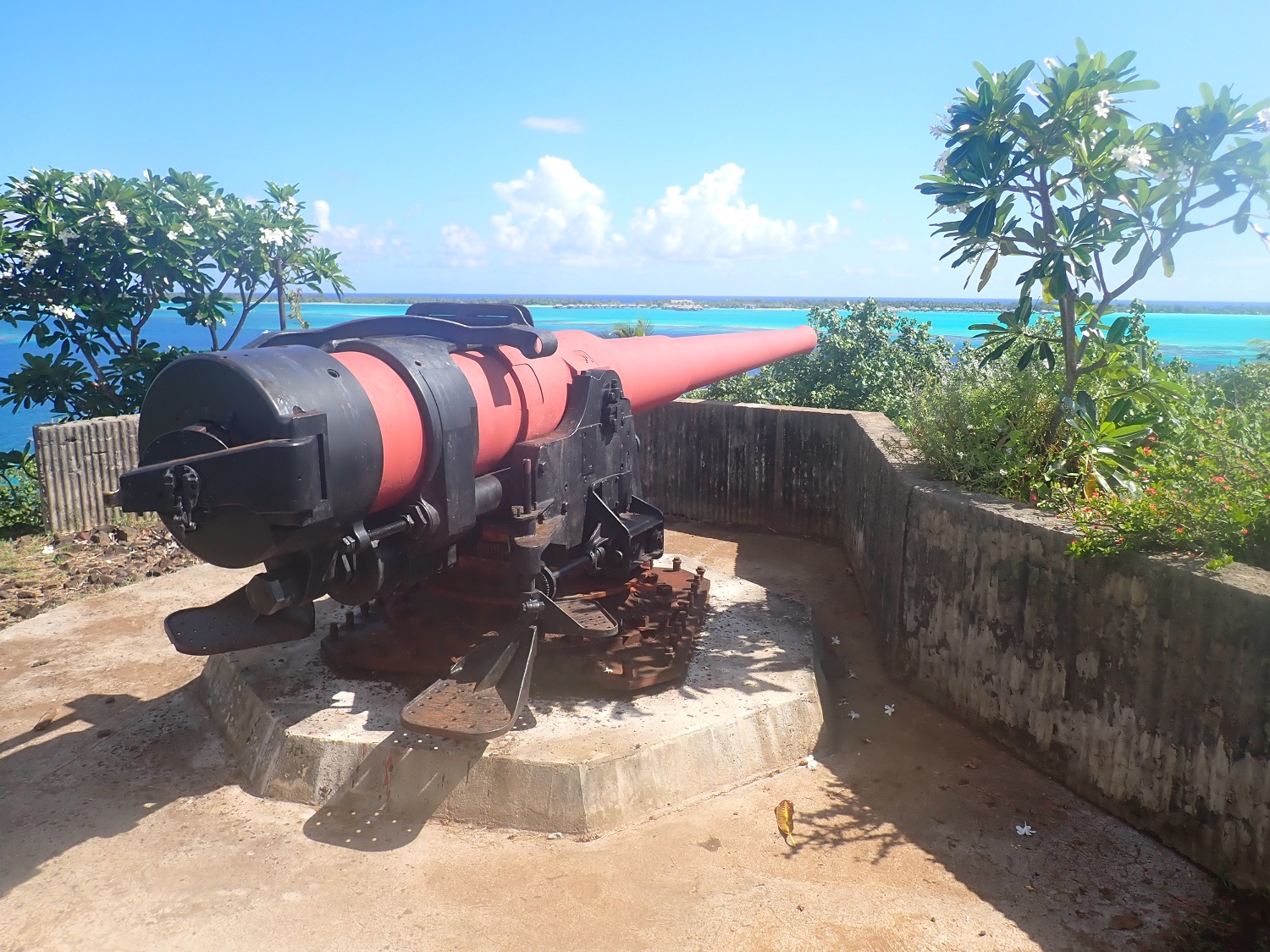
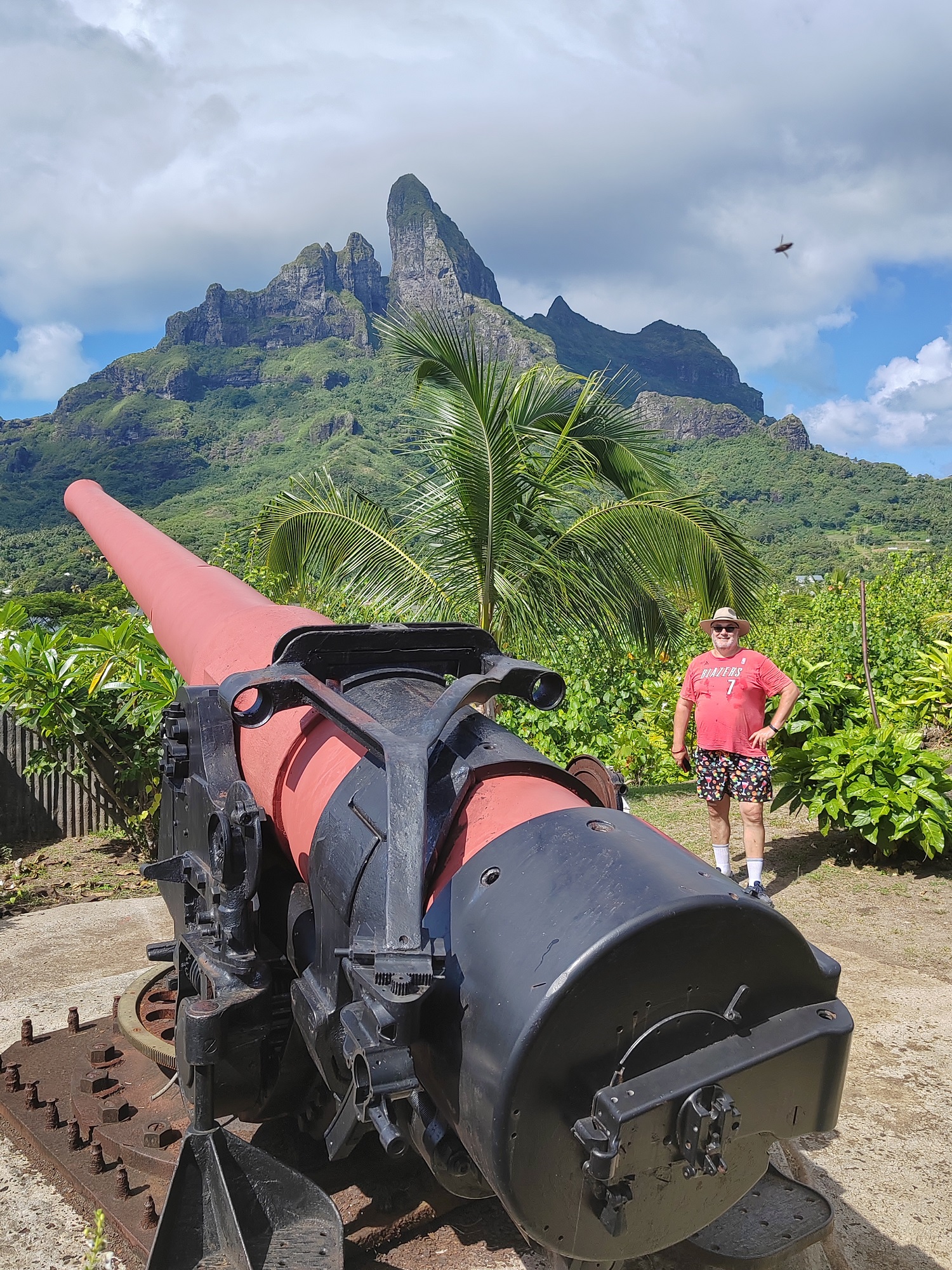
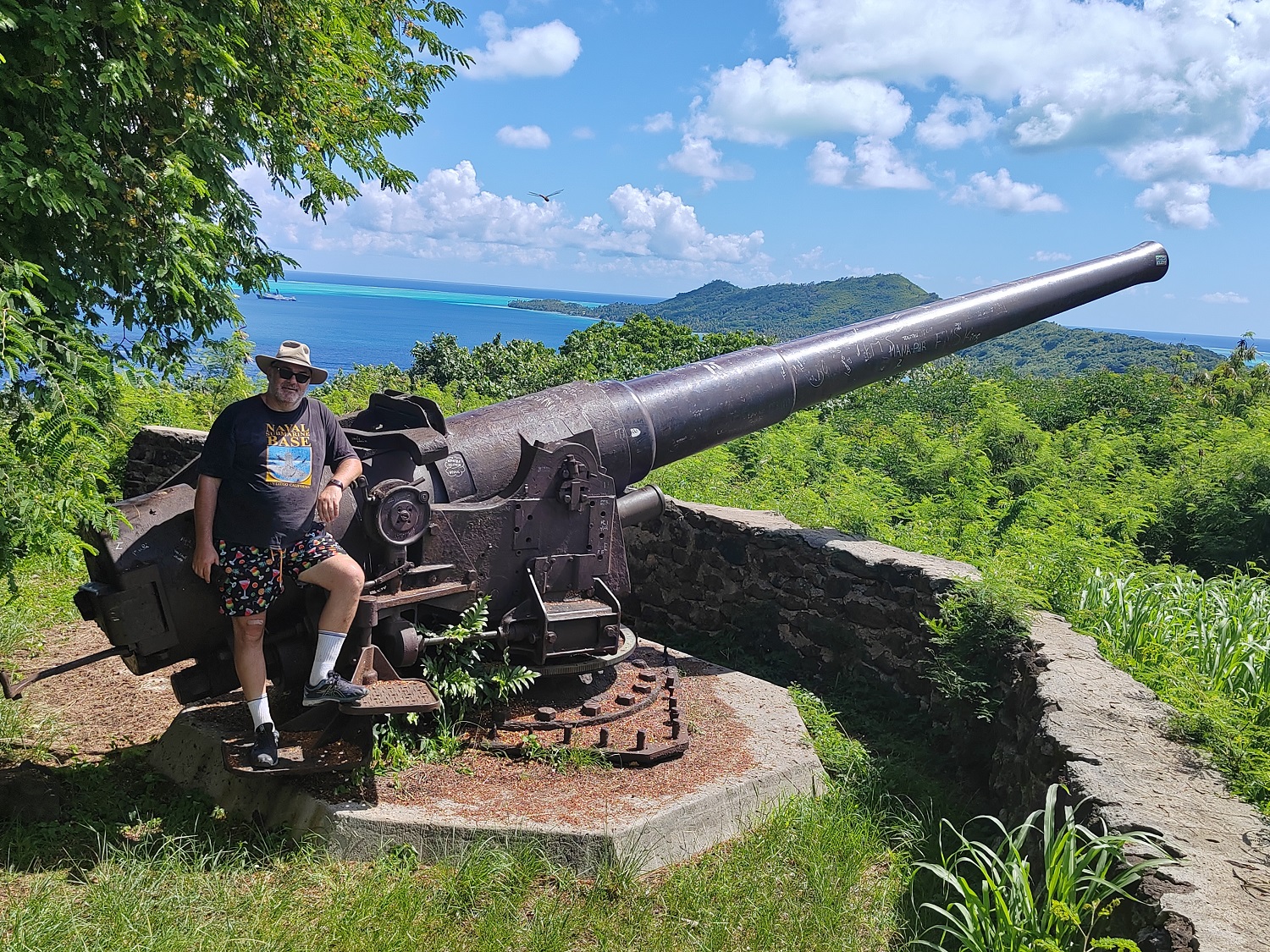
Breech engraving reads as follows:
| Engraving | Explanation |
|---|---|
| U.S. Naval Gun Factory W.N.Y. | U.S. Naval Gun Factory located at Washington Navy Yard, Washington D.C. |
| 7in Gun Mark II No. 82 | Caliber, Mark and Serial Number |
| Sup's E.H.C.L. | Initials of Supervisor |
| Insp'r P.W.F. | Initials of Inspector |
| P J.S. | Proved by J.S. |
| 29753 lbs. | Weight of gun less breech mechanism (13,496 kg) |
| 1908 | Year of manufacture |
| 1926IJ | Year of relining and initials of inspector |
"American Seacoast Defenses: A Reference Guide" and "Surviving American Seacoast Artillery Weapons: January 2023"
both by Mark A. Berhow of the Coast Defense Study Group
"Naval Weapons of World War Two" by John Campbell
"US Naval Weapons," "US Cruisers: An Illustrated Design History" and "US Battleships: An Illustrated Design History" all by Norman Friedman
---
"The Engineer" 27 April 1917 as quoted in Warship International No. 1, 1994
USNI Proceedings Vol. 45, No. 7, July 1919
---
"Naval Ordnance - A Text Book" revised in 1915 by Lt. Cmdr. Roland I. Curtain and Lt. Cmdr. Thomas L. Johnson
"U.S. Explosive Ordnance: Ordnance Pamphlet 1664 - May 1947" by Department of the Navy
"Range and Ballistic Tables 1935" by U.S. Department of Ordnance and Gunnery
"Handbook of Ordnance Data No. 1861, 15 November 1918" by United States Army Ordnance Department
"United States Naval Guns: Their Marks and Modifications" Ordnance Pamphlet No. 127, December 1916, Revised January 1918 (1st Revision)
"United States Naval Guns: Their Marks and Modifications" Ordnance Pamphlet No. 127, December 1916, Revised April 1942 (3rd Revision)
---
National Archives I, Washington, DC. Record Group 74, Entry 118. Navy gun record cards.
---
Gene Slover's Navy Pages
---
Special help from Charley Seavey, Glen Williford and Jean-Christophe Shigetomi, author of "Bobcats: Les Americains a Bora Bora 1942-1946,” a history of
the American forces on Bora Bora.
Interesting datapage on the tractor mounts:
Track-propelled Gun Mk.2 1918
15 August 2008 - Benchmark
29 March 2009 - Fixed typographical error
06 September 2009 - New pictures of mobile tractor mounting
16 October 2010 - Modified off-site Resources and added picture of railway mounting
21 July 2012 - Added a mention and photographs of Bora Bora guns
15 May 2015 - Redid photograph of USS Vermont and fixed link to Track-propelled Gun
28 December 2015 - Updated caption
30 July 2016 - Converted to HTML 5 format
03 January 2019 - Added sketch, reorganized notes
19 March 2019 - Added table for engravings
08 August 2022 - Added proved information
12 January 2023 - Added photographs by David Chessum and table of guns at Bora Bora
28 February 2023 - Updated link for Surviving American Seacoast Artillery Weapons
25 March 2023 - Updated Source Information for the guns on Bora Bora, added time of flight and maximum ordinate to range table

